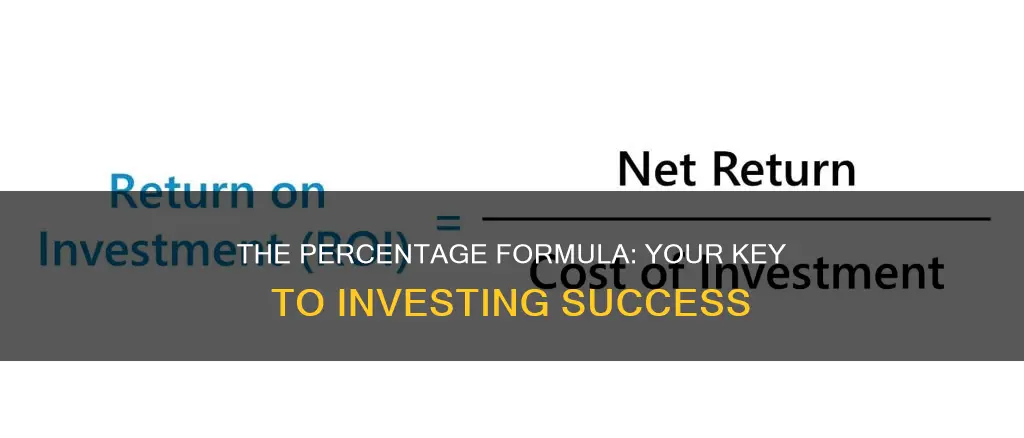
When investing, it's important to understand the percentage gain or loss on your investments to evaluate their performance and make informed decisions. This calculation provides insight into how your investments have grown or shrunk relative to their original value. The formula for calculating the percentage change is:
> [(Current Price - Original Price) / Original Price] x 100
For example, if you bought shares of a company at £50 per share and they are now worth £65, you would calculate a 30% gain: [(65 - 50) / 50] x 100 = 0.30 x 100 = 30%.
This formula is essential for quantifying and comparing the performance of different investments, making it a valuable tool for investors.
| Characteristics | Values |
|---|---|
| Formula | Percentage Gain = [(Current Price - Original Price) / Original Price] x 100 |
| Percentage Loss = [(Original Price - Current Price) / Original Price] x 100 | |
| Calculation | Percentage Gain = [(65 - 50) / 50] x 100 = 30% |
| Percentage Loss = [(80 - 60) / 80] x 100 = 25% | |
| Application | Used to measure investment income and track investing progress |
| Used to compare different investments | |
| Useful for long-term financial planning |
What You'll Learn

Percentage gain or loss
When investing, it's important to understand the percentage gain or loss on your investments, as this provides insight into the performance of your investment strategy. This calculation can be done in a few simple steps.
First, you need to know the original cost or purchase price of your investment. This information can be found on your Trade Confirmation sheets or provided by your broker. Next, calculate the gain or loss by subtracting the purchase price from the price at which you sold the investment. Then, take that number and divide it by the original cost of the investment. Finally, multiply that result by 100 to get the percentage change.
Percentage Gain/Loss = [(Current Price - Original Price) / Original Price] x 100
For example, if you bought shares of a company at £50 per share and now they are worth £65 per share, your calculation would be:
[(65 - 50) / 50] x 100 = (15 / 50) x 100 = 0.30 x 100 = 30% gain on your investment
It's important to note that this calculation can also be used to calculate an unrealized gain or loss, which is a gain or loss that you haven't realized yet because you still own the investment. In that case, simply substitute the current market price for the selling price.
Additionally, to get a true sense of your investment's performance, it's crucial to consider other factors such as dividends or interest, brokerage fees and transaction costs, capital gains tax, inflation, currency exchange rates, and compounding effects.
Calculating the percentage gain or loss is a powerful tool for investors as it provides context to your investment performance and allows for comparisons between different investments. It also assists in long-term financial planning and helps you evaluate your financial situation to make informed, risk-calculated decisions.
Importing Your Portfolio to Investing.com: A Step-by-Step Guide
You may want to see also

Compound interest
For example, imagine you put $1,000 into a savings account with an 8% annual interest rate. After the first year, your balance will be $1,080. The next year, you contribute another $1,000, and the 8% interest is calculated based on your total balance of $2,080. This means that at the end of the second year, your balance will be $2,246.40.
The Rule of 72 is a useful way to estimate how your investment will grow over time. If you know the interest rate, you can divide 72 by the interest rate to get the number of years it will take for your investment to double. For example, with an interest rate of 9%, your investment will double in value about every 8 years (72 divided by 9 equals 8).
The formula for calculating compound interest is:
> Compound interest = p [(1 + (r/n))^(nt) - 1]
Where:
- P = principal (the amount of money you start with)
- R = annual interest rate
- N = number of compounding periods
- T = number of years
Investment Management Services: What Do They Offer?
You may want to see also

Net gain or loss
Net gains or losses are the profits or losses made by an individual or business from selling an asset, writing off an asset, or making an investment. They are also used to determine a business's overall profit and the money left after expenses. Net gains and losses are calculated by subtracting the initial cost of an investment from its selling price.
For example, if you bought 50 shares at $10 each, you would have invested a total of $500. If you then sold those shares at $15 each, you would make a profit of $250. This is calculated as follows:
- Calculate the return: $15 x 50 = $750
- Subtract the initial cost from the return: $750 - $500 = $250
To turn this net gain into a percentage, divide the net gain by the original amount invested and multiply by 100. In this case, the calculation would be:
Net gain / original investment x 100: $250 / $500 x 100 = 50%.
So, in this example, you have made a net gain of 50%.
It is important to note that net gains and losses can also be influenced by other factors, such as dividends, interest, brokerage fees, transaction costs, capital gains tax, inflation, and currency exchange rates. These factors should be considered when evaluating the performance of an investment.
Consumer Credit Investing: Strategies for Success
You may want to see also

Unrealized gains and losses
For example, if you bought stock in a company at $30 per share and the most recent quoted price is $42, you'd be sitting on an unrealized gain of $12 per share. You could realize that gain if you sold the stock at $42 per share. Otherwise, your unrealized gain or loss will continue to fluctuate with the market share price.
An unrealized loss is the opposite of an unrealized gain. It occurs when the price of a current investment declines below its purchase price. For instance, if you buy shares in a company at $10 per share and the price plummets to $3 per share shortly after, you would have an unrealized loss of $7 per share.
Calculating Unrealized Gains and Losses
To calculate unrealized gains and losses, subtract the asset's value at the time it was purchased from its current market value. If the resulting amount is positive, the asset has gained value, and there are unrealized gains. If the amount is negative, there are unrealized losses.
For example, suppose an investor purchases 100 shares of a company at $10 each; they will have $1,000 worth of stock. If the value of the stock increases to $12 per share, they would now own $1,200 worth of stock. Since the investor has yet to sell the shares, they have an unrealized gain of $200.
Similarly, if an investor owns 100 shares of stock purchased at $10 each, and that stock decreases to $8 a share, they now own $800 worth of stock. The investor’s unrealized loss will be -$200.
In either case, the investor hasn’t actually profited or lost any money; they are paper gains or losses until they sell the asset and lock in the profit or the loss.
Investment Management Law: Understanding the Basics
You may want to see also

Percentage loss
When investing, it's important to understand the performance of your investments and how they are faring. This is where the concept of percentage loss comes in. Percentage loss is a metric that helps you evaluate the health of your investments by calculating the decrease in their value.
Formula for Percentage Loss
The formula for percentage loss is:
Here, the original price refers to the price at which you bought the investment, and the current price is the market price at a given time.
For example, let's say you bought shares of a company at £80 per share, and the current market price is £60 per share. Using the formula:
Importance of Understanding Percentage Loss
Understanding percentage loss is crucial for several reasons. Firstly, it gives you a standardised way to quantify the performance of your investments, making it easier to compare different assets. This is especially useful when evaluating different investment opportunities and deciding whether to buy, hold, or sell securities.
Additionally, knowing percentage losses helps you assess the impact of market downturns or underperforming assets on your portfolio. This information is valuable for risk management purposes, as it allows you to make informed decisions to secure your assets during periods of market instability.
Factors Affecting Percentage Loss
While the basic formula for calculating percentage loss is straightforward, it's important to consider other factors that may influence the actual performance of your investments:
- Dividends or interest: Include any dividends or interest earned to accurately assess total returns for stocks and bonds.
- Brokerage fees and transaction costs: Deduct these expenses to measure the true net performance of your investments.
- Capital gains tax: Take this into account to calculate the actual return on your investment accurately.
- Inflation: Consider inflation to understand the real purchasing power of your investment returns over time.
- Currency exchange rates: If you have foreign investments, factor in exchange rates to assess their true performance.
- Compounding effect: Understand the compounding effect to grasp the overall growth of your long-term investments.
- Market volatility: Analyse how values change over fixed time periods to make more informed investment decisions.
By considering these factors along with the percentage loss formula, you can make more informed decisions about your investment portfolio and work towards achieving your financial goals.
Global Macro Strategy: Investment Management Explained
You may want to see also
Frequently asked questions
First, determine the original cost or purchase price of your investment. Next, subtract this from the price at which you sold the investment to get the gain or loss. Then, divide the gain or loss by the original cost of the investment and multiply the result by 100.
Calculating the percentage gain or loss on an investment gives you insight into the performance of your investment and your investment strategy. It also helps you compare the performance of different investments and determine if you are meeting your financial goals.
In addition to the basic formula, you may want to consider including dividends or interest, deducting brokerage fees and transaction costs, accounting for inflation, and factoring in currency exchange rates, among other things.







